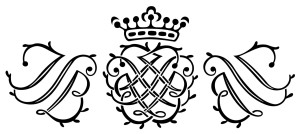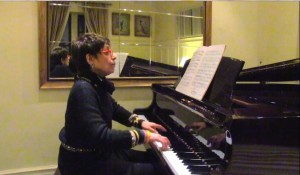The six Bach French Suites, collections of short pieces, written by Bach for his second wife during their early marriage, are an enchanting choice for the student of adult piano lessons and amateur pianists. We examine the Bach French Suites from multiple perspectives as part of Grand Piano Passion™‘s popular Classical Piano Music Amplified™ series.
An Accessible Path to Bach
The Bach French Suites, groupings of short pieces originally most likely written for the harpsichord, now played on the piano, provide many of the benefits of studying more complicated music by Bach. “What the average amateur of the present day lacks in theoretical musical education is supplied for him by these works of Bach,” waxes Albert Schweitzer, the great humanitarian and musicologist in his biography originally published in 1911, the two-volume J. S. Bach (Dover, 1966). From the suites, Schweitzer explains, the amateur “unconsciously imbibes certain principles of thematic formation, of part writing, of modulation and of construction, and from which he acquires a certain unconscious critical faculty, that protects him against inferior art.”
Interestingly, Bach never published the French Suites, perhaps, Schweitzer speculates, “because they did not strike him as sufficiently difficult and ingenious.” Bach only dedicated the time and expense of engraved issues for those works that would enhance his reputation with professional musicians and connoisseurs. Luckily for those of us studying the piano today, the French Suites survived, offering an accessible path to Bach.
The Musical Character of the Bach French Suites
The pieces in the Bach French Suites are “focused stylizations of the traditional dances,” says Christoph Wolff in his Pulitzer Prize finalist, Johann Sebastian Bach: The Learned Musician (W. W. Norton, 2000), stylizations inspired by French and Italian dance forms such as the courante, sarabande, and gavotte. Most likely, Bach did not intend for the music to be danced to, especially since at the time of his composing, some of the dance forms which inspired him were obsolete.
In this excellent summary from Johann Sebastian Bach: The Culmination of an Era (Oxford University Press, 1966), Karl Geiringer deftly summarizes the character of this “strongly cohesive set”: The first three suites have a more serious character and they are written in the minor mode; they are followed three serene and even joyful pieces in major keys. Numbers 1 through 4 are in six movements, Number 5 has seven, and Number 6 has eight movements. It appears that the sequence of the suites may even correspond to the chronological order [in which Bach composed them]… Numbers 5 and 6 are the latecomers in this collection. They bring the set to a climactic conclusion, for they belong to Bach’s finest clavier music… Especially the bright and spirited finale of Number 5 [performed above by James Rhodes] presents one of the most attractive Gigues Bach has written.
The Diversity within the French Suites
A Gigue is not a Gigue: although movements across the six Bach French Suites are spiritually linked, they can differ quite dramatically in terms of their feeling and texture. By way of demonstration, here is the Courante from Suite No. 2 played by Angela Hewitt juxtaposed next to the Courante from Suite No. 6 performed by András Schiff…
Angela Hewitt: Courante from No. 2
András Schiff: Courante from No. 6
…and the Sarabande from Suite No. 5 performed by Mitsuko Uchida compared to the Sarabande from Suite No. 3 played by Emre Elivar:
Mitsuko Uchida: Sarabande from No. 5
Emre Elivar: Sarabande from No. 3
To Pedal or Not to Pedal, That Is the Question
Studying the Baroque-era Bach French Suites on our modern day piano raises the question of whether and how much the pianist ought to pedal. Opinions on this question starkly diverge. “The French Suites were written for a harpsichord, and ideally they should be played on a harpsichord,” says Shirley Gruenhut, an accomplished pianist who video-recorded two of the Fifth Suite’s movements for Grand Piano Passion™. “If you play this music on the piano, I believe the use of the pedal is repugnant,” declares Gruenhut. “The damper pedal will slur the notes and mar the inherent skill of the keyboard artist to produce a lyrical line. Bach should not be played with pedal on a piano, not ever.”
In contrast, Mark Pakman, adjunct professor at the John J. Cali School of Music, advocates use of the pedal. “I strongly believe that pedal should be used in Bach’s music for connections and color, to imitate organ, harpsichord, or chorus, depending on the piece, the harpsichord in the case of the Bach French Suites. However, the pedal should be used with discretion and understanding as to what is appropriate for that style,” Professor Pakman concludes. Ultimately, the adult piano student, in conference with his or her piano teacher, needs to make a personal decision.
The Bittersweet History of the Bach French Suites
The history of the Bach French Suites are intertwined with a bittersweet period in Bach’s married life. In May of 1720, Bach embarked on a trip with the court of Prince Leopold for the natural spring at Carlsbad. Bach must have felt uneasy being away for two months from his four children and Maria Barbara, his wife with whom he had, according to one son, a blissful marriage. When Bach returned home, writes Paul Elie in Reinventing Bach (Farrar, Strauss, and Giroux, 2012), he found Maria Barbara “dead and buried, although he had left her hale and hearty on his departure. The news that she had been ill and died reached him only when he entered his own house.”
Perhaps, Paul Elie reports, Maria Barbara died in childbirth, but in either case Bach now was a single father of four, mourning. But “for all the sickness and death in his family, Bach was lucky in love,” writes Elie. He fell in love again, this time with Anna Magdalena Wülcken, a soprano.
Not long after they were married, “Anna Magdalena started an album, in which Johann Sebastian entered compositions for her to play in order to improve and cultivate her keyboard skills or that he would play to entertain her,” explains Wolff. The music included “five short yet highly refined harpsichord suites,” early versions of what would become the six French Suites. While this music was most likely performed at court, Wolff explains, it also hints at “the couple’s intimate and serious musical companionship.”
Today classical musicians often shortcut this story, saying that Bach gave Anna Magdalena the album as a wedding gift—”beats a Harrod’s china set,” jokes the concert pianist James Rhodes. The fact that Bach composed the music as a personal gift to a beloved only increases its allure for practicing pianists.




0 Comments